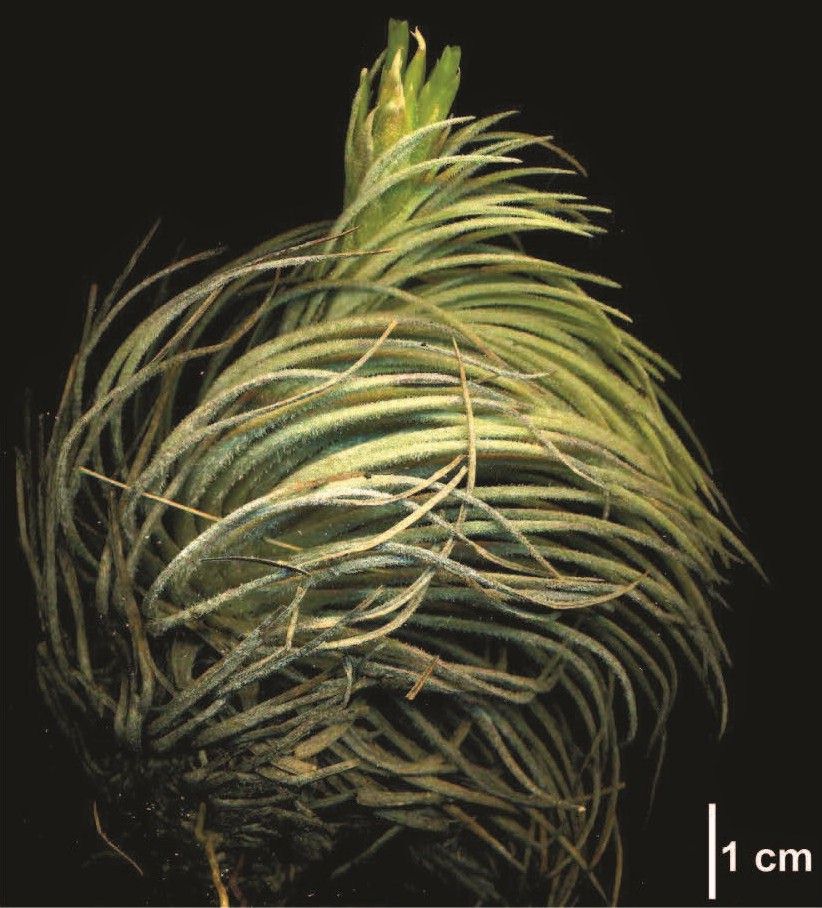

Viridantha uniflora Hernandez-Cárdenas, Espejo & López-Ferr., sp. nov. Phytokeys 132: 99-110. 2019
Diagnosis. Viridantha uniflora is similar to V. boqueronensis but differs in the shape (square vs. ovate to triangular) and the width of the leaf sheath (0.7–0.8 cm vs. 1 cm); the width (0.4–0.5 cm vs. 0.7–1.3 cm) of the spikes, the number of flowers per spike (always 1 vs. 2–5); and in the shape of the floral bract (ovate vs. elliptic).
Type. MEXICO. Oaxaca: Distrito de Juxtlahuaca, municipio de Santos Reyes Tepejillo, en los alrededores del boquerón de Santos Reyes Tepejillo (17°26'58"N, 97°56'29"W), 1960 m a.s.l., 21 April 2018, R. Hernández-Cárdenas, E. Negri & J. Conde 2156 (holotype: UAMIZ!; isotype: MEXU!).
Description. Plants saxicolous, flowering 7–10 cm tall, 7–9 cm diameter; rosettes acaulescent, solitary or caespitose, falcate in outline.
Leaves numerous, shorter or equalling the inflorescence;
sheaths pale brown on both surfaces, nearly square, 0.8–1 cm long, 0.7–1 cm wide, glabrous towards the base on both surfaces;
blades falcate, densely greyish lepidote, narrowly triangular, 3–6 cm long, 0.3–0.4 cm wide, apical portion long attenuate.
Inflorescence pedunculated, falcate, one-branched, with 3–5 spikes;
peduncle 2.5–3.5 cm long, 0.2–0.3 cm diameter, covered by the bracts of the peduncle;
peduncle bracts similar to the leaves but reducing in size towards the apical portion, densely greyish lepidote;
spikes green, erect and appressed, flattened, elliptic, 1.3–1.5 cm long, 0.4–0.5 cm wide;
flowers erect and appressed, only one per spike;
floral bracts green to green-brownish, ovate, 1–1.5 cm long, 0.5–0.6 cm wide, apex acute to acuminate, ecarinate to slightly carinate at the apex, glabrous adaxially, lepidote abaxially;
sepals green, lanceolate, 1–1.3 cm long, 0.3–0.4 cm wide, apex acute, the two adaxial ones carinate, both surfaces glabrous or lepidote abaxially mainly on the keel;
petals dark green, narrowly oblong, 1.5–1.8 cm long, 0.2–0.3 cm wide, apex rounded to obtuse;
filaments white, 0.8–1.2 cm long, included;
anthers pale green, 1.2–1.5 mm long;
ovary green, ellipsoid, 2.5–3 mm long, 2–3 mm diameter; style white, 8–10 mm long; style branches green.
Capsules not seen.
Habitat and ecology. Viridantha uniflora is only known from the boquerón of the Santos Reyes Tepejillo municipality, located in the Sierra Madre del Sur in the northwest region of the state of Oaxaca, where it grows on vertical walls in dry oak forests and tropical deciduous forests. The plants of V. uniflora grow in colonies, between 1700 and 1900 m a.s.l., on the cliffs of the boquerón amongst other saxicolous herbs.
Phenology. The plants of Viridantha uniflora bloom in April and May.
Etymology. The specific epithet refers to the presence of one flower per spike, condition only known in the proposed taxon.
Observations. Plants of Viridantha uniflora had previously been collected by J.I. Calzada 20057 (MEXU), but had been wrongly identified as V. atroviridipetala (Matuda) Espejo. However, V. uniflora differs from V. atroviridipetala in the outline shape of the rosettes (falcate vs. spherical); in the shape of the leaf sheaths (square vs. oblong to ovate); in the shape of the floral bracts (ovate vs. lanceolate to narrowly triangular) and in the number of flowers per spike (1 vs. 2–5). Viridantha boqueronensis and V. penascoensis grow in nearby locations to the type locality of V. uniflora, but without overlapping its distributions. These species share the saxicolous habit and the falcate rosettes in outline. However all these species are easily distinguishable from the newly proposed taxon (Table 2). Viridantha uniflora differs from V. penascoensis in the inflorescence (branched vs. simple); in the length and in the colour (green vs. red-pink) of the spikes (1.3–1.5 cm vs. 2–3 cm). Viridantha uniflora differs from V. boqueronensis in the shape of the leaf sheaths (square vs. ovate to triangular); in the number of flowers per spike (1 vs. 2–5); in the colour of the spikes (green vs. green with red-pink); in the shape of the floral bracts (ovate vs. elliptic); and in the presence or not of a keel on the floral bracts (absent or visible only in the apex vs. present along the bract).
Additional specimens examined (paratypes). MEXICO, Oaxaca: Distrito Santiago Juxtlahuaca, municipio de Santos Reyes Tepejillo. 3 km al N de Santos Reyes Tepejillo rumbo a Corral de Piedra (17°27'N, 97°57'W), 1770 m a.s.l., 20 July 1995, J. I. Calzada 20057 (MEXU); en los alrededores del boquerón de Santos Reyes Tepejillo (17°26'58"N, 97°56'29"W), 1960 m a.s.l., 18 March 2017, R. Hernández-Cárdenas, F. Gómez y A. González 2120 (UAMIZ). 107